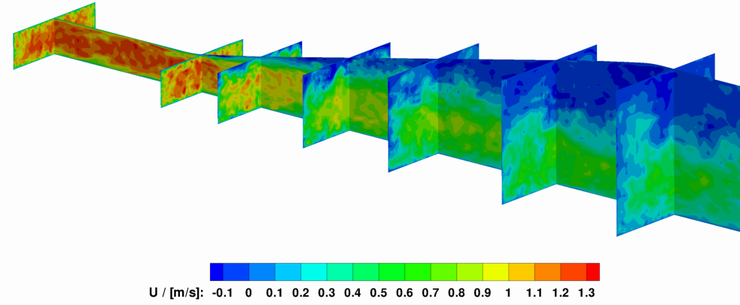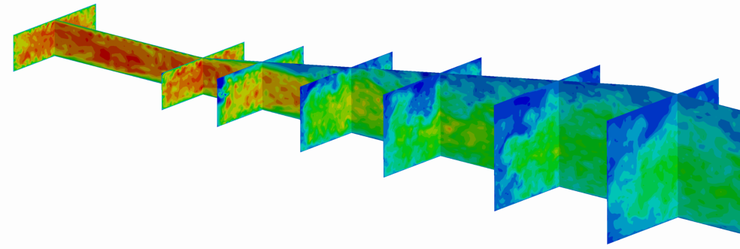Abstr:UFR 4-16: Difference between revisions
| (17 intermediate revisions by the same user not shown) | |||
| Line 9: | Line 9: | ||
=== Underlying Flow Regime 4-16 === | === Underlying Flow Regime 4-16 === | ||
= Abstract = | = Abstract = | ||
The incompressible flow developing fully in a three-dimensional duct and | The incompressible flow developing fully in a three-dimensional duct and | ||
then expanding into a diffuser, whose upper wall and one side wall are | then expanding into a diffuser, whose upper wall and one side wall are | ||
appropriately deflected, has been investigated experimentally | appropriately deflected, has been investigated experimentally | ||
(Cherry ''et al.'', 2008, 2009) and computationally by means of DNS (Direct Numerical | ([[UFR_4-16_References#7|Cherry ''et al.'', 2008]], [[UFR_4-16_References#8|2009]]) | ||
Simulation; Ohlsson ''et al.'', 2009, | and computationally by means of DNS (Direct Numerical | ||
Simulation; | |||
[[UFR_4-16_References#23|Ohlsson ''et al.'', 2009]], [[UFR_4-16_References#24|2010]]), | |||
LES (Large-Eddy Simulation) as | |||
well as by different hybrid LES/RANS and RANS (Reynolds-Averaged Navier-Stokes) models. | well as by different hybrid LES/RANS and RANS (Reynolds-Averaged Navier-Stokes) models. | ||
The results of the computational studies were analysed | The results of the computational studies were analysed | ||
along with the experimental reference database in the framework of two | along with the experimental reference database in the framework of two | ||
workshops on ''“Refined Turbulence Modelling”'' | workshops on ''“Refined Turbulence Modelling”'' | ||
(Steiner ''et al.'', | ([[UFR_4-16_References#30|Steiner ''et al.'', 2009]] and | ||
[[UFR_4-16_References#15|Jakirlić ''et al.'', 2010b]]) | |||
Turbulence Modelling (SIG15). Two three-dimensional diffuser configurations | organized by the ERCOFTAC Special Interest Group on | ||
Turbulence Modelling (SIG15). | |||
The flow was also a test case in the European ATAAC project. | |||
Two three-dimensional diffuser configurations | |||
differing in terms of the values of the expansion angles — the upper-wall | differing in terms of the values of the expansion angles — the upper-wall | ||
expansion angle is reduced from 11.3° (diffuser 1) to 9° (diffuser 2); the | expansion angle is reduced from 11.3° (diffuser 1) to 9° (diffuser 2); the | ||
| Line 29: | Line 33: | ||
geometry led to substantial changes in the flow structure with respect to | geometry led to substantial changes in the flow structure with respect to | ||
the onset, location, shape and size of the three-dimensional separation | the onset, location, shape and size of the three-dimensional separation | ||
pattern associated with the corner separation and corner reattachment, | pattern associated with the corner separation and corner reattachment, | ||
1. The inflow in both considered cases is characterized by a Reynolds | [[UFR_4-16#figure1|Fig. 1]]. | ||
The inflow in both considered cases is characterized by a Reynolds | |||
number Re<sub>h</sub>=10000, based on the inlet duct height. | number Re<sub>h</sub>=10000, based on the inlet duct height. | ||
The primary objective of the present contribution is twofold: | The primary objective of the present contribution is twofold: | ||
| Line 38: | Line 42: | ||
*a comparative assessment of different modelling approaches in terms of their capability to accurately capture the size and shape of the three-dimensional flow separation pattern and associated mean flow and turbulence features. | *a comparative assessment of different modelling approaches in terms of their capability to accurately capture the size and shape of the three-dimensional flow separation pattern and associated mean flow and turbulence features. | ||
<div id="figure1"></div> | <div id="figure1"></div> | ||
{|align="center" border="0" width="750" | {|align="center" border="0" width="750" | ||
|[[Image:UFR4-16_figure1a.png|center|740px]] | |[[Image:UFR4-16_figure1a.png|center|740px]] | ||
|- | |- | ||
|[[Image:UFR4-16_figure1b.png|center|740px]] | |[[Image:UFR4-16_figure1b.png|center|740px]] | ||
|- | |- | ||
|'''Figure 1:''' Instantaneous velocity field in both diffuser configurations, diffuser 1 (upper) and diffuser 2 (lower), obtained by a zonal hybrid LES/RANS model, illustrating different flow separation patterns (from | |'''Figure 1:''' Instantaneous velocity field in both diffuser configurations, diffuser 1 (upper) and diffuser 2 (lower), obtained by a zonal hybrid LES/RANS model, illustrating different flow separation patterns (from [[UFR_4-16_References#14|Jakirlić ''et al.'', 2010a]]). Whereas the separation zone spreads over the upper wall in the diffuser 1, it occupies the deflected side wall in the diffuser 2 | ||
|} | |} | ||
| Line 62: | Line 56: | ||
---- | ---- | ||
{{ACContribs | {{ACContribs | ||
|authors=Suad | |authors=Suad Jakirlić, Gisa John-Puthenveettil | ||
|organisation=Technische Universität Darmstadt | |organisation=Technische Universität Darmstadt | ||
}} | }} | ||
Latest revision as of 08:27, 30 April 2013
Flow in a 3D diffuser
Confined flows
Underlying Flow Regime 4-16
Abstract
The incompressible flow developing fully in a three-dimensional duct and then expanding into a diffuser, whose upper wall and one side wall are appropriately deflected, has been investigated experimentally (Cherry et al., 2008, 2009) and computationally by means of DNS (Direct Numerical Simulation; Ohlsson et al., 2009, 2010), LES (Large-Eddy Simulation) as well as by different hybrid LES/RANS and RANS (Reynolds-Averaged Navier-Stokes) models. The results of the computational studies were analysed along with the experimental reference database in the framework of two workshops on “Refined Turbulence Modelling” (Steiner et al., 2009 and Jakirlić et al., 2010b) organized by the ERCOFTAC Special Interest Group on Turbulence Modelling (SIG15). The flow was also a test case in the European ATAAC project. Two three-dimensional diffuser configurations differing in terms of the values of the expansion angles — the upper-wall expansion angle is reduced from 11.3° (diffuser 1) to 9° (diffuser 2); the side-wall expansion angle is increased from 2.56° (diffuser 1) to 4° (diffuser 2) — were considered. These slight modifications in the diffuser geometry led to substantial changes in the flow structure with respect to the onset, location, shape and size of the three-dimensional separation pattern associated with the corner separation and corner reattachment, Fig. 1. The inflow in both considered cases is characterized by a Reynolds number Reh=10000, based on the inlet duct height.
The primary objective of the present contribution is twofold:
- to provide further insight into the physics of the separation of the three-dimensional boundary layer generated at the intersection of two deflected walls. This separation is the consequence of an adverse pressure gradient evoked by the duct expansion under different conditions and
- a comparative assessment of different modelling approaches in terms of their capability to accurately capture the size and shape of the three-dimensional flow separation pattern and associated mean flow and turbulence features.
| Figure 1: Instantaneous velocity field in both diffuser configurations, diffuser 1 (upper) and diffuser 2 (lower), obtained by a zonal hybrid LES/RANS model, illustrating different flow separation patterns (from Jakirlić et al., 2010a). Whereas the separation zone spreads over the upper wall in the diffuser 1, it occupies the deflected side wall in the diffuser 2 |
Contributed by: Suad Jakirlić, Gisa John-Puthenveettil — Technische Universität Darmstadt
© copyright ERCOFTAC 2024


